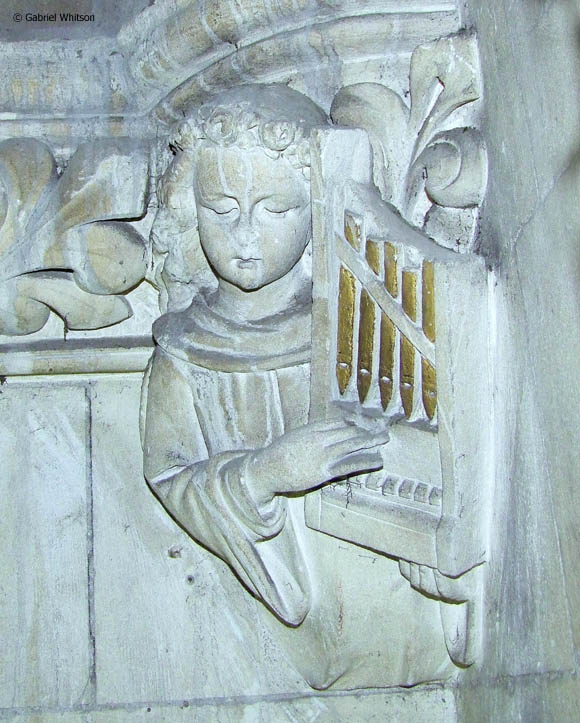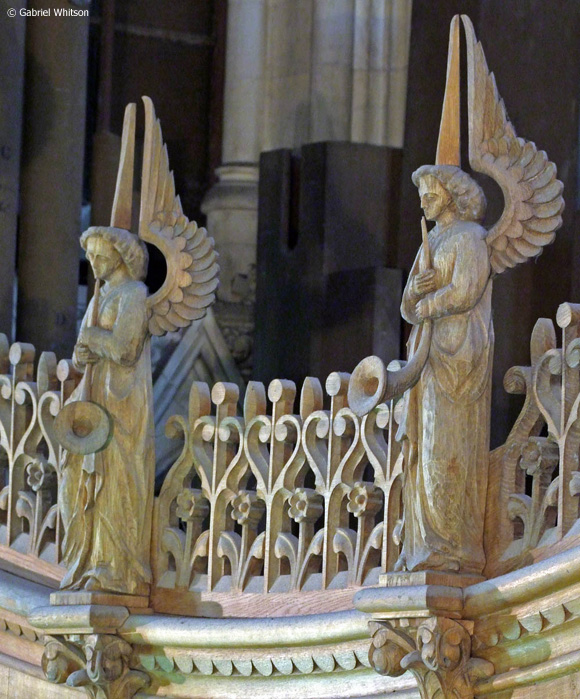Disposition
erbaut: Telford & Telford, 1905
restauriert: Irish Organ Company, 1967
Restaurierung "in progress": Fratelli Ruffatti snc, Padua, 2017
| Great |
Swell |
Choir |
Pedal |
| Double salicional 16' |
Lieblich Gedackt 16' |
Stopped diapason 8' |
Violone 16' |
| Bourdon 16' |
Open diapason 8' |
Dolce 8' |
Open Diapason 16' |
| Diapason I 8' |
Gedackt 8' |
Flute 4' |
Bourdon 16' |
| Diapason II 8' |
Dulciana 8' |
Nazard 2 2/3' |
Quint 10 2/3' |
| Gamba 8' |
Voix Celeste 8' |
Piccolo 2' |
Cello 8' |
| Stopped diapason 8' |
Principal 4' |
Tierce 1 3/5' |
Octave 8' |
| Flute 8' |
Wald flute 4' |
Clarinet 8' |
Flute 8' |
| Quint 5 1/3' |
Harmonic Piccolo 2' |
|
Bombarde 16' |
| Principal 4' |
Mixture III |
Choir octave |
Trumpet 8' (from 16') |
| Flute 4' |
Double Bassoon 16' |
Swell to choir |
|
| Gemshorn 4' |
Cornopean 8' |
Tremulant |
|
| Twelfth 2 2/3' |
Oboe 8' |
|
|
| Fifteenth 2' |
Clarion 4' |
|
|
| Mixture III |
|
|
|
| Double trumpet 16' |
Swell octave |
|
|
| Trumpet 8' |
Tremulant |
|
|
| Clarion 4' |
|
|
|
|
|
|
|
| Swell to great |
Swell to pedal |
|
|
| Swell octave to great |
Great to Pedal |
|
|
| Choir to great |
Choir to Pedal |
|
|
| Choir octave to great |
Great Pistons to Pedal Piston |
|
Accessories:
6 thumb pistons to Swell Organ, 6 thumb pistons to Great and Pedal Organs, 4 thumb pistons to Choir Organ, 6 toe pistons to Swell Organ, 6 toe pistons to Great and Pedal Organs, Toe pistons Bombarde 16' and Great to Pedal.
Swell Pedal; Crescendo Pedal.
Ein zweiter Spieltisch steht im Querschiff der Kirche.
|
Geschichte der Orgel (Übersetzung folgt)
The Pipe Organ of St. Colman's Cathedral, Cobh, County Cork, Ireland.
The organ of St. Colman's Cathedral was first installed in 1905. Aptly described in "The Cork Examiner" newspaper of July 21 of that year as "the crowning work in the interior equipment of the sacred edifice", this magnificent instrument was built by Telford & Telford. This world-famous firm of organ builders was founded in Dublin in 1830 by the Englishman William Telford (1809-1885), who had learnt his craft under the great French organ-builder Cavaillé-Coll, whose influence is usually evident in the specifications of most Telford organs. Telford visited Paris in 1846 as the guest of Cavaillé-Coll and attended the inauguration of the organ at the Madeleine. He was appointed adjudicator of organs at the Great Exhibition of 1851 in London, awarding first prize to Henry Willis who went on to have a brilliant career as Britain's leading organ builder. There are hundreds of examples of Telford's work all over Ireland, and as far distant as Australia New Zealand, Fiji and the Malvinas (Falkland Islands), in various states of repair and preservation. Sadly, very few are in original condition and many have been altered almost beyond recognition. In a report of their survey carried out in 1965, the famous organ builders of Henry Willis & Sons Limited (see above) described the organ of St. Colman's Cathedral as being "an exquisite example of the work of Messrs. Telford & Telford of Dublin". Other experts have equally as complimentary: “undoubtedly one of Telford’s largest and most prestigious organs”, “a monumental instrument, built on a grand scale”, “of enormous significance and heritage value”, “the most important surviving Telford instrument and the least altered”. The Telford firm ceased trading in 1929.
The organ is located in the west gallery. The Austrian oak case, modelled in gothic tracery, rises to a height of 45 feet (14 metres) on either side. Filling the openings are 77 highly polished and burnished decorative pipes of pure tin. The actual organ pipes (there are some 2,500 of them) are placed behind the casework, together with the bellows and other mechanism. The motor and blower are located in a special room in the cathedral tower. The action of the organ was originally tubular pneumatic, but this was changed to electro pneumatic during a major rebuild in the early 1970's. The console has three manuals and a pedal-board; there are 46 speaking stops, as well as combination stops and pistons. From this extensive palette a wide variety of colours is possible, ranging from the mellow tones of the flue pipes to the brassy sounds of the reeds and the deep-voiced grandeur of the 16' pedal stops. A further enhancement is the fine acoustical properties of the building itself and in particular the ceiling of Californian pitch pine. A second, almost identical, console is located near the high altar.
|


